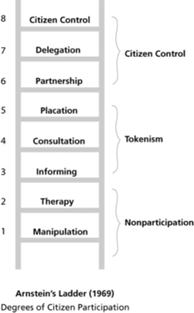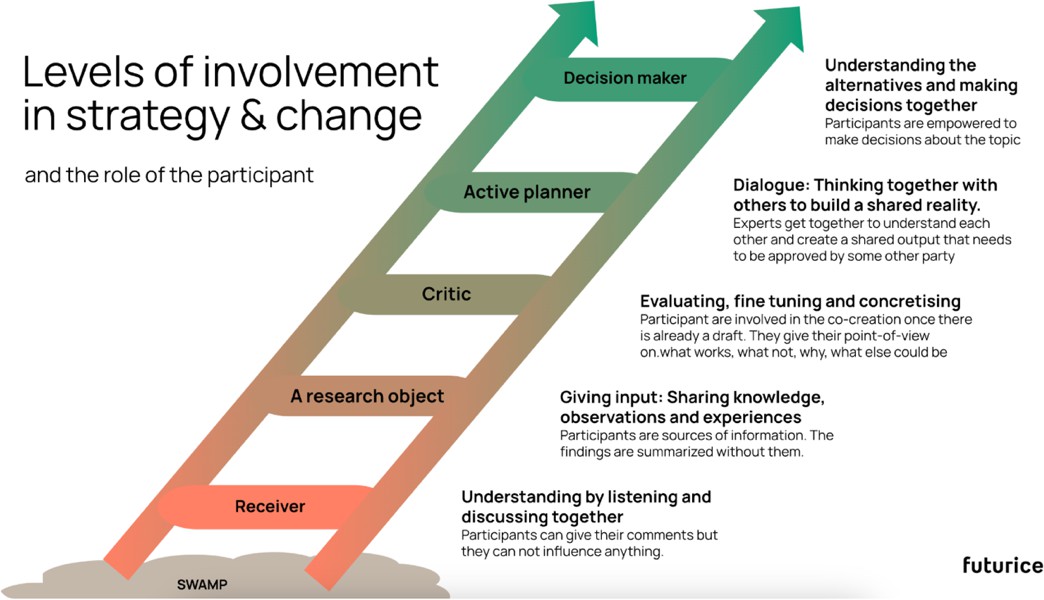The role of civil servants
One of the challenges in citizen engagement is determining the right level of involvement. The traditional approach often leans towards one-way communication, where governments inform or consult citizens without truly integrating their input into decision-making. In 1969 Sherry Arnstein developed what is nowadays referred to as “Arnstein’s ladder of participation”.

The ladder is a guide to seeing who has power when important decisions are being made.1
In the AoCE-network partners are long beyond many of the stages described in Arnstein’s ladder. They are primarily looking for ways to create the partnership, delegation or citizen control described in Arnstein’s ladder. When looking at the efforts the partners in the AoCE Network are putting in citizen participation it seems more appropriate to look at a different ladder, the “ladder of involvement in strategy and change”2
Interesting is the way in this particular article, the writer describes two types of persons and organizations and how their way of working, their approach creates a huge difference in how to include others in decision-making. This description is very much in line with earlier findings within our AoCE network as to why it is difficult for many government organizations to introduce and work with citizen participation. Van der Beek describes two schools of thought:
Traditionally, civil servants work in a certain field based on their expertise. This automatically creates an expert-focused organization, not automatically focused on including citizens and active co- creation. It means civil servants must navigate between two schools of thought:
Expert-led decision-making, where professionals diagnose issues and propose solutions.
Co-creation-focused approaches, where citizens and stakeholders actively contribute to shaping policies and projects.
A balanced approach is needed—one that combines expert knowledge with citizen perspectives to create policies that are both effective and widely supported. The AoCE network has demonstrated that participation is most impactful when tailored to the specific needs of communities, ensuring that engagement is not just symbolic but genuinely influential.The AoCE network tries to create (new) ways to help the civil servants within their organizations learn to navigate between these two schools of thought and implement different actions to do so.
The city of Genk, our lead partner, is developing a “toolbox” for its employees. The toolbox provides information on different ways to work with citizens, when to use which methods, and provides additional help to colleagues when working with these methods, amongst others, through their dedicated participation officer.
In the city of Banska Bystrica “breakfast meetings” for civil servants were introduced, to create an environment where they can meet and discuss their questions and wishes regarding citizen participation. This way they create a group of civil servants that is willing to work with new and different methods to engage with citizens, who then also become strong ambassadors for these new ways of working.
A third way of helping government organizations to learn to navigate between expert-led decision- making on the one hand and a more co-creation-focused approach is found by many of the partner cities: working with a participation office or dedicated participation office, where colleagues can ask for information on citizen participation processes and that can offer assistance to them for implementation. In our network the cities of Genk, Banska Bystrica, Gdansk and Aarhus already have this type of officers in place. The cities of Budaörs, Breda and Quart de Poblet are working on their introduction.
Addressing Trust and Polarization
Another significant barrier to effective citizen participation is the growing distrust between citizens and authorities, often increased by polarization. This is an issue that seriously affects partner cities in the network in their search for (new) ways and methods to include citizens in decision-making processes. The AoCE network partners have recognized the need for trust-building measures, such as:
Transparency in decision-making: Clearly communicating how citizen input is used to avoid perceptions of "token" participation3. The city of Quart de Poblet for this reason decided to work on improving their web platform for the presentation of the Transparency Portal. It has been changed to have a tool that allows to incorporate new features that allow not only to comply with the obligations of information and transparency that marks the law, but also to create a clear, complete and truthful platform for communication of the work of management with the citizens.
Training for civil servants: Enhancing their ability to facilitate discussions in polarized contexts, ensuring they remain neutral brokers rather than enforcers of top-down decisions. In Aarhus the goal is to create and host a course on how to create a local dialogue event with politicians running for local elections together with civil society. The course will contain skills such as: Developing an open agenda, being a good host, facilitating good conversation, knowledge of democratic chain of governance and training skills in deliberation. Also the city of Genk has decided to work on this topic. They are working together with their HR department
Introducing digital tools: partner city Budaörs and also the city of Gdansk are looking for ways to include more people in the decision making process and/or to communicate about decisions and share information. Budaörs aims to introduce Maptionnaire, an Application of map-based questionnaires for citizen participation, together with a participatory budget: Maptionnaire. While Gdansk aims to establish a digital platform for participatory processes in the city, a platform where citizens can be engaged, and information collected.
Personalized engagement: Engaging communities through direct, face-to-face interactions. In the city of Kekava, community events in different neighbourhoods will be organized together with networking events in order to reach out to citizens and via this way engage them in decision making. Whereas in Iasi Metropolitan Municipality the focus is specifically towards engaging youngsters. For that reason, they work on the renovation of a youth hub to establish an appropriate framework for conducting activities. In Breda, they seek cooperation with NGO’s through so-called “Waardenetwerken”(value networks)4. This way they increase their connection with NGO’s as a local government, but also the connection between different NGO’s working in the same field of policy.
When searching for even more ways to address this issue of trust and polarization, I read an interesting essay, recently published by prof. Peter Scholten and mr. Jack Mikkers, mayor of the city of ‘s-Hertogenbosch.5 In the essay, they quite clearly describe how political discourse frequently simplifies social diversity into rigid categories, reinforcing an "us versus them" mentality. However, local governments can counteract this by fostering a more inclusive and precise language in their policies. One that acknowledges the complexity of diverse communities rather than reducing them to stereotypes.When combined with a so-called precision approach to reach out to people, this leads to better understanding of decisions and more acceptance.
Also, the essay focuses on the important aspect of “identity”: in more and more multicultural societies polarization can easily grow, also because people feel neglected. If you look at local level however, most people living in a city feel a strong commitment to that city. Therefor, Scholten and Mikkers suggest to work with citizens on embracing that commitment and the values they share. This vision is supported by developments in some cities in our AoCE network. The city of Aarhus has developed the Aarhus Compass6, and Lead Partner, the city of Genk, has “the Genker Habits”, a set of 4 groundrules that apply to all Genkenaren7. These habits were established through an initiative called “the 22”. This was a deliberative process that brought together 22 citizens from various ethnic, social, and educational backgrounds.
The initiative sought to address a central question: What unites us as citizens of Genk? The process revealed key principles such as mutual respect, active listening, and the value of integration over assimilation. Participants agreed on the importance of preserving individual cultural identities while embracing a collective "Genk DNA."
When searching for ways to increase trust and prevent polarization initiatives like these can be very helpful, together with careful use of language and a precision approach, engaging with citizens on a personal level.
Conclusion: Civil Servants are Agents of Change
Effective citizen participation is not about inviting citizens to meetings or a survey. It requires a cultural shift within local administrations. The AoCE network provides a valuable model for rethinking the role of civil servants as facilitators of dialogue, trust, and co-creation. By adopting these lessons, municipalities can move beyond symbolic participation and build stronger, more inclusive democratic communities.
Citizen participation asks the city to work as a broker, as was said by Magdalena Skiba when she was interviewed for the AoCE-podcast “Talks with Change Agents.”8 And it asks of government organizations, especially their (political) leaders, to create space for experimentation, even allowing civil servants to take calculated risks and learn from mistakes. This approach underpins a broader cultural shift in governance, where trust, dialogue, and shared ownership of decisions take precedence.
The AoCE network places a strong emphasis on equipping civil servants with the skills and mindset needed to support participatory governance. Many municipalities struggle with an expertise gap, where technical staff (e.g., urban planners) are not trained in participatory methods. To bridge this gap, the network promotes:
Training in facilitation skills, helping civil servants engage with citizens effectively.
Cross-sectoral collaboration, encouraging different departments to work together to integrate participation into everyday governance.
Experimentation and learning, creating spaces where civil servants can test new engagement approaches without fear of failure.
The partner cities showcase innovative participation models, from deliberative citizen panels to the city acting as a broker between various stakeholders. These initiatives emphasize that citizen participation must be embedded in the culture of local governance rather than treated as an occasional outreach effort.
For municipalities looking to enhance citizen participation, the following steps can serve as a roadmap:
Assess current participation practices: Identify where engagement efforts fall on the participation ladder and adjust accordingly.
Build internal capacity: Train civil servants in participatory methods and create roles dedicated to fostering engagement.
Design inclusive processes: Ensure that participation is accessible, considering diverse groups and potential barriers to involvement.
Monitor and adapt: Regularly evaluate the impact of engagement initiatives and refine approaches based on lessons learned.
In the final year of the AoCE action planning network, the collaboration will focus on new working methods and ways to improve citizen participation. Knowledge the network is happy to share.
References:
1 See https://citizenshandbook.org/arnsteinsladder.html for more information
2 See https://www.futurice.com/blog/ladder-of-participation, a blog by Piritta van der Beek, consultant at Futurice.
3 “token” participation is decribed in Arnstein’s ladder of participation.
4 See: https://www.breda.nl/waardenetwerken
5 https://www.binnenlandsbestuur.nl/sociaal/naar-een-nieuw-samenlevingsperspectief-onze-diverse-gemeenten
6 https://faellesomaarhus.aarhus.dk/media/us3jfyx5/aarhuskompassetlight-uk.pdf
8 https://open.spotify.com/episode/33d1B1f4femyxcW87dpMU7?si=BE2VNi7OSLeyv8P6zriopw
